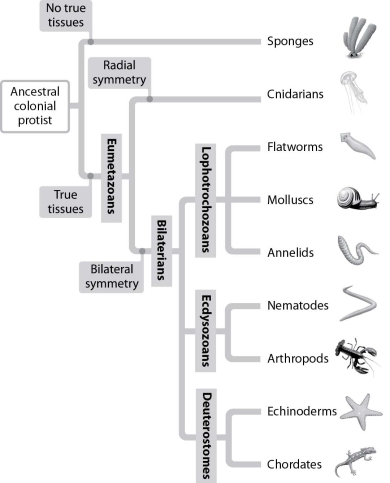A) complete digestive tract
B) exoskeleton
C) segmentation
D) three true tissue layers
Correct Answer

verified
Correct Answer
verified
Multiple Choice
According to the "new" revised phylogeny based on genetic analyses, annelids are a member of the Lophotrochozoa and are most closely related to which of the following groups?
A) echinoderms
B) molluscs
C) cnidarians
D) arthropods
Correct Answer

verified
Correct Answer
verified
Multiple Choice
Animals that are segmented and have jointed appendages and an exoskeleton are members of the phylum
A) Platyhelminthes.
B) Annelida.
C) Cnidaria.
D) Arthropoda.
Correct Answer

verified
Correct Answer
verified
Multiple Choice
Which of the following statements about deuterostomes is true?
A) Deuterostomes lack true tissues.
B) Deuterostomes have only two tissue layers.
C) The opening that forms during deuterostome gastrulation becomes the anus.
D) The opening that forms during deuterostome gastrulation becomes the mouth.
Correct Answer

verified
C
Correct Answer
verified
Multiple Choice
After reading the paragraphs below, answer the questions that follow. Corals belong to phylum Cnidaria. The reefs themselves are made up of millions of polyps, each of which secretes a calcium carbonate skeleton that becomes part of the reef structure. Corals, which are attached to the reef as adults, have free-swimming larvae that develop into new polyps. Corals are actually colorless. The brilliant colors that are visible on the reef come from the zooxanthellae (microscopic algae) that live within their body tissues. The zooxanthellae and corals have a symbiotic relationship in which corals provide carbon dioxide and mineral nutrients (released as wastes from coral digestion) to the zooxanthellae. The zooxanthellae perform photosynthesis. Photosynthesis produces nutrients (in the form of sugars) for the coral and also releases oxygen. This relationship supplements energy from predation and allows corals to survive in clear tropical water, even though these areas have very low nutrient levels. -Corals supplement the energy they receive from the zooxanthellae by capturing prey with their
A) amoebocytes.
B) cnidocytes.
C) choanocytes.
D) osteocytes.
Correct Answer

verified
Correct Answer
verified
Multiple Choice
Use the figure below to answer the questions that follow.
.
 -Which group of animals is the most diverse?
-Which group of animals is the most diverse?
A) Sponges
B) Deuterostomes
C) Bilaterians
D) Eumetazoans
Correct Answer

verified
Correct Answer
verified
Multiple Choice
Suppose you use a dissecting microscope to observe organisms that have colonized discs of densely packed, fibrous wood (Masonite plates) that have been submerged in 6 inches of lake water for eight weeks. You see insect cases (protective shelters) , insect larvae, and newly emerged insects with wings. You determine that you are looking at an insect species
A) that undergoes incomplete metamorphosis.
B) that undergoes complete metamorphosis.
C) with a body plan of radial symmetry.
D) with complete digestive tracts.
Correct Answer

verified
Correct Answer
verified
Multiple Choice
Which of the following phyla is most closely related to echinoderms?
A) Annelida
B) Mollusca
C) Arthropoda
D) Chordata
Correct Answer

verified
Correct Answer
verified
Multiple Choice
A dog's head is at its ________ end, and its belly is its ________ surface.
A) posterior; dorsal
B) anterior; dorsal
C) posterior; ventral
D) anterior; ventral
Correct Answer

verified
Correct Answer
verified
Multiple Choice
Animals directly evolved from
A) plants.
B) protists.
C) fungi.
D) bacteria.
Correct Answer

verified
B
Correct Answer
verified
Multiple Choice
The most numerous, diverse, and widespread animals are the
A) Arthropoda.
B) Mollusca.
C) Annelida.
D) Chordata.
Correct Answer

verified
Correct Answer
verified
Multiple Choice
A bilaterally symmetrical, wormlike animal that has a complete digestive tract and a cuticle could be a member of which of the following phyla?
A) Cnidaria
B) Annelida
C) Nematoda
D) Chordata
Correct Answer

verified
Correct Answer
verified
Multiple Choice
Which of the following features is unique to chordates?
A) bilateral symmetry
B) a coelom
C) a notochord
D) a complete digestive tract including an anus
Correct Answer

verified
Correct Answer
verified
Multiple Choice
Complete metamorphosis is considered to occur in a species
A) if the larva and adult have different diets.
B) if the larva and adult live in different habitats.
C) if a pupation stage separates the larval and adult stages.
D) if the adult has wings, but the larva does not.
Correct Answer

verified
Correct Answer
verified
Multiple Choice
The ________ is a flagellated cell that sweeps water through a sponge's body.
A) choanocyte
B) amoebocyte
C) spicule
D) spongin
Correct Answer

verified
Correct Answer
verified
Multiple Choice
Most adult insects have three major body parts or sections. They are the
A) head, body, and legs.
B) head, thorax, and abdomen.
C) antennae, head, and abdomen.
D) legs, wings, and body.
Correct Answer

verified
Correct Answer
verified
Multiple Choice
Which part of this figure shows the tube feet of the starfish? 
A) structure A
B) structure B
C) structure C
D) structure D
Correct Answer

verified
Correct Answer
verified
Multiple Choice
A typical sponge is best described as
A) a slow-moving suspension feeder with a true coelom.
B) a sessile suspension feeder with bilateral symmetry.
C) a slow-moving carnivore with no true tissues or symmetry.
D) a sessile suspension feeder with no true tissues or body symmetry.
Correct Answer

verified
D
Correct Answer
verified
Multiple Choice
Typical animal embryos have ________, or external cell layer, and ________, which lines the digestive tract.
A) an ectoderm; a blastula
B) an ectoderm; an endoderm
C) an endoderm; an ectoderm
D) a mesoderm; a gastrula
Correct Answer

verified
Correct Answer
verified
Multiple Choice
Which of the following are not included among the eumetazoans that have true tissues?
A) sea stars (Echinodermata)
B) earthworms (Annelida)
C) sea anemones (Cnidaria)
D) sponges (Porifera)
Correct Answer

verified
Correct Answer
verified
Showing 1 - 20 of 72
Related Exams